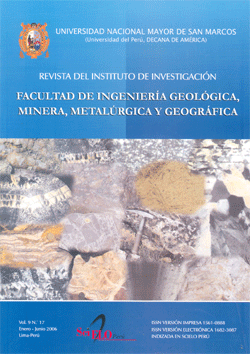Las rocas graníticas y la mineralización aurífera asociada,en la Cordillera Oriental del norte del Perú 6°30-7°30.
DOI:
https://doi.org/10.15381/iigeo.v9i17.2885Palabras clave:
Batolito, Estructura, Mineralización, GeoquímicaResumen
En la parte norte del Perú entre el río Marañón y la Cordillera Oriental en el Norte del Perú se encuentra el Batolito Gollón - Callangate conformado por cuerpos plutónicos discontinuos a lo largo de 100 km, entre Santo Tomás y Bambamarca, tiene como hospedantes rocas metamórficas del Complejo del Marañón y rocas sedimentarias del Paleozoico inferior. El Batolito está conformado por las unidades Gollón, Balsas, Lavador, Los Alisos, que son en su mayoría granodioritas a tonalitas de grano medio y las unidades Abra Chanchillo, Yalen, Enaben, Callangate y Chacanto cuya composición modal corresponde esencialmente a granitos (monzogranitos - sienogranitos). Las texturas y estructuras son primarias e isótropas y los minerales comunes son: plagioclasas, feldespato K, cuarzo, biotita y hornablenda, y como accesorios más comunes: apatito, zircón, magnetita y otros óxidos. En las unidades Gollón, Lavador, esquistos del Complejo del Marañón y pelitas pizarrosas consideradas como Formación Contaya, se encuentran vetas de cuarzo con contenidos de oro. Las vetas de cuarzo Au en rocas graníticas son mas frecuentes, siguen en general la dirección NO - SE con inclinaciones de 30º a 75º al NE sus grosores de 0,2 m a 1,2 m. Las vetas en el complejo metamórfico son muy irregulares, concuerdan con la esquistosidad N 40° - 50° O inclinadas al NE (El Reo y Horabuena). Las vetas de cuarzo Au representan tres estadios en su proceso de formación, el inicial con cuarzo lechoso, rutilo; la etapa I donde el cuarzo gris se infiltra conjuntamente con sulfuros (pirita, esfalerita, calcopirita, moscovita en la alteración), luego en el estadio II las soluciones precipitan cuarzo gris, galena, con sulfosales, electrum, oro y plata nativa. Posteriormente la infiltración meteórica da lugar a alteración supérgena que ocasiona la formación de covelita, hematita-limonitas, hidróxidos de manganeso, carbonatos. Los elementos mayores expresados a través de los diagramas AFM, y el contenido de SiO2 versus K2O + Na2O y K2O indican que las rocas graníticas del Batolito de Gollón - Callangate son calco alcalinas, subalcalinas y en su mayoría con alto contenido de K. Mientras que los elementos traza generan un gráfico tipo araña, representativo de una tendencia de evolución calco alcalina característica de un ambiente de subducción. Las rocas plutónicas según las relaciones de yacencia se han emplazado entre el Misissipiano Inferior – Pensilvaniano inferior, y algunas dataciones K-Ar publicadas (Sánchez A., 1995) rinden edades de 346 a 329 millones de años para en las unidades Balsas y Callangate. La mineralización de oro debe haberse emplazado luego de la formación de las rocas ígneas en el Pensilvaniano temprano, por correlación con aquella mineralización de Pataz. Las estructuras con mayor potencial en contenido de Au son aquellas que se encuentran en las granodioritas y tonalitas de grano medio, siguiendo la estructura regional; así mismo aquellas que se encuentran en los esquistos verdes asociados con diques máficos.Descargas
Publicado
Número
Sección
Licencia
Derechos de autor 2006 Agapito Wilfredo Sánchez Fernández

Esta obra está bajo una licencia internacional Creative Commons Atribución-NoComercial-CompartirIgual 4.0.
LOS AUTORES RETIENEN SUS DERECHOS:
a. Los autores retienen sus derechos de marca y patente, y tambien sobre cualquier proceso o procedimiento descrito en el artículo.
b. Los autores retienen el derecho de compartir, copiar, distribuir, ejecutar y comunicar públicamente el articulo publicado en la Rev. Inst. investig. Fac. minas metal cienc. geogr. (por ejemplo, colocarlo en un repositorio institucional o publicarlo en un libro), con un reconocimiento de su publicación inicial en la Rev. Inst. investig. Fac. minas metal cienc. geogr.
c. Los autores retienen el derecho a hacer una posterior publicación de su trabajo, de utilizar el artículo o cualquier parte de aquel (por ejemplo: una compilación de sus trabajos, notas para conferencias, tesis, o para un libro), siempre que indiquen la fuente de publicación (autores del trabajo, revista, volumen, numero y fecha).






